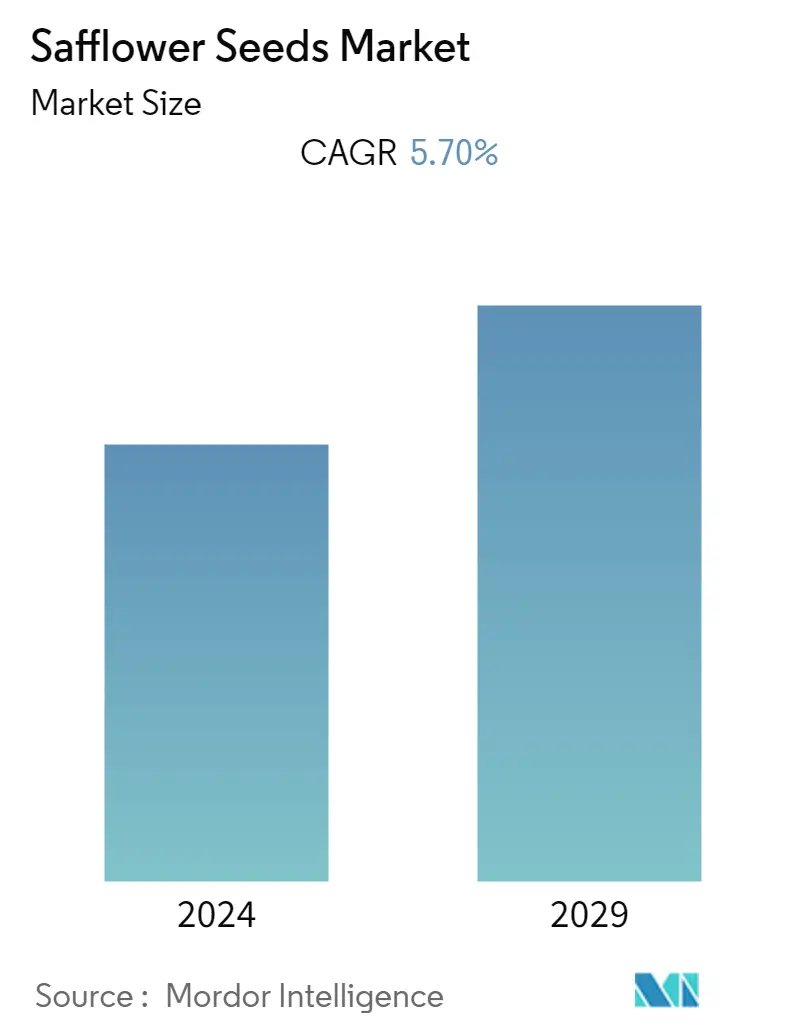Market Size of Safflower Seeds Industry

| Study Period | 2019 - 2029 |
| Base Year For Estimation | 2023 |
| Forecast Data Period | 2024 - 2029 |
| CAGR | 5.70 % |
| Fastest Growing Market | North America |
| Largest Market | Middle-East and Africa |
Major Players
*Disclaimer: Major Players sorted in no particular order |
Safflower Seeds Market Analysis
The safflower seeds market is projected to reach a CAGR of 5.7% over the forecast period (2020-2025). The global safflower oil consumption is growing rapidly, mainly as a result of the rising health consciousness among consumers across the world. Safflower oil is a popular cooking oil that comes from the seeds of the safflower plant. According to the Food and Agriculture Organization (FAO), Kazakhstan, India, the United States of America, Mexico, Argentina, and Australia are the primary producers of safflower seed mainly for oil extraction rotational crops along with rice, wheat, and corn. According to FAO, Kazakhstan produced safflower seeds of 214149 tonnes in 2018 up from 167243 tonnes in 2016. Safflower seed production in Kazakhstan exceeded the figures recorded by the second-largest producer, the U.S. (107220 tonnes, 2018), threefold. California is the primary producer of safflower seeds in the united states, accounting for 50% of the production. Safflower seed is a drought-tolerant oilseed, with Lower production inputs, easy adaptability to various soil types, effective in crop rotation, effective weed and disease controller, Lower risk of production, ease of harvesting and storage are some of the factors driving the demand for safflower seed across the globe.
Safflower Seeds Industry Segmentation
Safflower seeds are fruits of the safflower plant, which are produced majorly in the Middle Eastern and North American countries. There are two main types of safflower, one type of safflower produces seeds that are high in monounsaturated fatty acid, while the other produces seeds that are high in polyunsaturated fatty acid. The report covers safflower seeds (Carthamus tinctorius) production, consumption, trade, and price trend analysis.
| Geography | ||||||||||||||||||||||||||||||||||||||||||||
| ||||||||||||||||||||||||||||||||||||||||||||
| ||||||||||||||||||||||||||||||||||||||||||||
| ||||||||||||||||||||||||||||||||||||||||||||
| ||||||||||||||||||||||||||||||||||||||||||||
|
Safflower Seeds Market Size Summary
The safflower seeds market is experiencing significant growth, driven by the increasing global demand for safflower oil, which is favored for its health benefits and versatility in culinary applications. This oil, derived from safflower seeds, is gaining popularity due to its monounsaturated and polyunsaturated fatty acid content, making it a preferred choice for cooking oils, infant formulas, and cosmetics. The market is supported by key producing countries such as Kazakhstan, India, the United States, Mexico, Argentina, and Australia, with Kazakhstan leading in production. The safflower plant's drought tolerance, low production inputs, and adaptability to various soil types contribute to its rising demand, particularly in regions where it serves as an effective crop rotation option and a controller of weeds and diseases.
In addition to its culinary uses, safflower seeds are also valued for their by-products, such as safflower meal, which is high in protein and fiber, making it a suitable supplement for livestock and poultry feed. Innovations in oil extraction processes, like the use of supercritical CO2, have enhanced the quality of safflower oil, further boosting its market appeal. Russia plays a significant role in the safflower seeds market, both as a producer and exporter, with substantial exports to countries like Turkey, Belgium, and the Netherlands. The Russian government's national project aims to increase the export of oil and fat products, including safflower oil, highlighting the crop's importance in the region. The health benefits of safflower oil, such as cholesterol reduction and improved skin and hair health, continue to drive its popularity and export potential.
Safflower Seeds Market Size - Table of Contents
-
1. MARKET DYNAMICS
-
1.1 Market Overview
-
1.2 Market Drivers
-
1.3 Market Restraints
-
1.4 Value Chain Analysis
-
-
2. MARKET SEGMENTATION
-
2.1 Geography
-
2.1.1 North America
-
2.1.1.1 United States
-
2.1.1.1.1 Production Analysis
-
2.1.1.1.2 Consumption Analysis and Market Value
-
2.1.1.1.3 Import Market Analysis by Volume & Value
-
2.1.1.1.4 Export Market Analysis by Volume & Value
-
2.1.1.1.5 Price Trend Analysis
-
-
2.1.1.2 Mexico
-
2.1.1.2.1 Production Analysis
-
2.1.1.2.2 Consumption Analysis and Market Value
-
2.1.1.2.3 Import Market Analysis by Volume & Value
-
2.1.1.2.4 Export Market Analysis by Volume & Value
-
2.1.1.2.5 Price Trend Analysis
-
-
-
2.1.2 Europe
-
2.1.2.1 Russia
-
2.1.2.1.1 Production Analysis
-
2.1.2.1.2 Consumption Analysis and Market Value
-
2.1.2.1.3 Import Market Analysis by Volume & Value
-
2.1.2.1.4 Export Market Analysis by Volume & Value
-
2.1.2.1.5 Price Trend Analysis
-
-
2.1.2.2 Spain
-
2.1.2.2.1 Production Analysis
-
2.1.2.2.2 Consumption Analysis and Market Value
-
2.1.2.2.3 Import Market Analysis by Volume & Value
-
2.1.2.2.4 Export Market Analysis by Volume & Value
-
2.1.2.2.5 Price Trend Analysis
-
-
-
2.1.3 Asia Pacific
-
2.1.3.1 China
-
2.1.3.1.1 Production Analysis
-
2.1.3.1.2 Consumption Analysis and Market Value
-
2.1.3.1.3 Import Market Analysis by Volume & Value
-
2.1.3.1.4 Export Market Analysis by Volume & Value
-
2.1.3.1.5 Price Trend Analysis
-
-
2.1.3.2 India
-
2.1.3.2.1 Production Analysis
-
2.1.3.2.2 Consumption Analysis and Market Value
-
2.1.3.2.3 Import Market Analysis by Volume & Value
-
2.1.3.2.4 Export Market Analysis by Volume & Value
-
2.1.3.2.5 Price Trend Analysis
-
-
2.1.3.3 Australia
-
2.1.3.3.1 Production Analysis
-
2.1.3.3.2 Consumption Analysis and Market Value
-
2.1.3.3.3 Import Market Analysis by Volume & Value
-
2.1.3.3.4 Export Market Analysis by Volume & Value
-
2.1.3.3.5 Price Trend Analysis
-
-
-
2.1.4 South America
-
2.1.4.1 Argentina
-
2.1.4.1.1 Production Analysis
-
2.1.4.1.2 Consumption Analysis and Market Value
-
2.1.4.1.3 Import Market Analysis by Volume & Value
-
2.1.4.1.4 Export Market Analysis by Volume & Value
-
2.1.4.1.5 Price Trend Analysis
-
-
-
2.1.5 Middle East & Africa
-
2.1.5.1 Turkey
-
2.1.5.1.1 Production Analysis
-
2.1.5.1.2 Consumption Analysis and Market Value
-
2.1.5.1.3 Import Market Analysis by Volume & Value
-
2.1.5.1.4 Export Market Analysis by Volume & Value
-
2.1.5.1.5 Price Trend Analysis
-
-
2.1.5.2 Tanzania
-
2.1.5.2.1 Production Analysis
-
2.1.5.2.2 Consumption Analysis and Market Value
-
2.1.5.2.3 Import Market Analysis by Volume & Value
-
2.1.5.2.4 Export Market Analysis by Volume & Value
-
2.1.5.2.5 Price Trend Analysis
-
-
2.1.5.3 Kazakhstan
-
2.1.5.3.1 Production Analysis
-
2.1.5.3.2 Consumption Analysis and Market Value
-
2.1.5.3.3 Import Market Analysis by Volume & Value
-
2.1.5.3.4 Export Market Analysis by Volume & Value
-
2.1.5.3.5 Price Trend Analysis
-
-
2.1.5.4 Kyrgyzstan
-
2.1.5.4.1 Production Analysis
-
2.1.5.4.2 Consumption Analysis and Market Value
-
2.1.5.4.3 Import Market Analysis by Volume & Value
-
2.1.5.4.4 Export Market Analysis by Volume & Value
-
2.1.5.4.5 Price Trend Analysis
-
-
2.1.5.5 Iran
-
2.1.5.5.1 Production Analysis
-
2.1.5.5.2 Consumption Analysis and Market Value
-
2.1.5.5.3 Import Market Analysis by Volume & Value
-
2.1.5.5.4 Export Market Analysis by Volume & Value
-
2.1.5.5.5 Price Trend Analysis
-
-
2.1.5.6 Ethiopia
-
2.1.5.6.1 Production Analysis
-
2.1.5.6.2 Consumption Analysis and Market Value
-
2.1.5.6.3 Import Market Analysis by Volume & Value
-
2.1.5.6.4 Export Market Analysis by Volume & Value
-
2.1.5.6.5 Price Trend Analysis
-
-
-
-
Safflower Seeds Market Size FAQs
What is the current Safflower Seeds Market size?
The Safflower Seeds Market is projected to register a CAGR of 5.70% during the forecast period (2024-2029)
Which is the fastest growing region in Safflower Seeds Market?
North America is estimated to grow at the highest CAGR over the forecast period (2024-2029).

